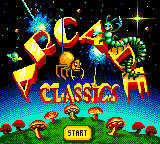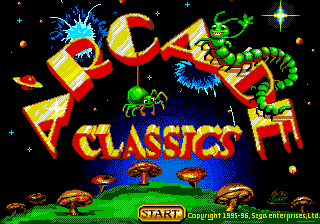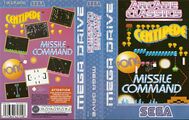Difference between revisions of "Arcade Classics"
From Sega Retro
m (→External links: post-mortem link) |
m (→External links) |
||
| Line 164: | Line 164: | ||
==External links== | ==External links== | ||
| − | *[https://web.archive.org/web/20101115232724/http://www.abaker.com/genclass.htm Arcade Classics] post-mortem by developer [[Al Baker]] at [https://web.archive.org/web/20101115232724/http://www.abaker.com/ Al Baker & Associates official website] (Wayback Machine) | + | *''[https://web.archive.org/web/20101115232724/http://www.abaker.com/genclass.htm Arcade Classics]'' post-mortem by developer [[Al Baker]] at [https://web.archive.org/web/20101115232724/http://www.abaker.com/ Al Baker & Associates official website] (Wayback Machine) |
*''[http://gdri.smspower.org/wiki/index.php/Blog:Arcade_Classics_(Game_Gear/Genesis) Blog: Arcade Classics]'' post at [http://gdri.smspower.org/ Game Developer Research Institute] | *''[http://gdri.smspower.org/wiki/index.php/Blog:Arcade_Classics_(Game_Gear/Genesis) Blog: Arcade Classics]'' post at [http://gdri.smspower.org/ Game Developer Research Institute] | ||
Revision as of 19:42, 29 September 2021
| |||||||||||||||||||||||||
| Arcade Classics | |||||||||||||||||||||||||
|---|---|---|---|---|---|---|---|---|---|---|---|---|---|---|---|---|---|---|---|---|---|---|---|---|---|
| System(s): Sega Game Gear, Sega Mega Drive | |||||||||||||||||||||||||
| Publisher: Sega | |||||||||||||||||||||||||
| Developer: Al Baker & Associates[1] | |||||||||||||||||||||||||
| Original system(s): Arcade boards, Atari Ultra Pong | |||||||||||||||||||||||||
| Developer(s) of original games: Atari | |||||||||||||||||||||||||
| Game total: 3 | |||||||||||||||||||||||||
| Sound driver: GEMS | |||||||||||||||||||||||||
| Peripherals supported: Gear-to-Gear Cable | |||||||||||||||||||||||||
| Genre: Compilation | |||||||||||||||||||||||||
| Number of players: 1-2 | |||||||||||||||||||||||||
|
Arcade Classics is a Sega Game Gear game compilation consisting of the Atari-developed Centipede, Ultra Pong, and Missile Command, developed by Al Baker & Associates and published by Sega. Released exclusively in the United States in 1996, it was also ported to the Sega Mega Drive by the same developer and published in the United States, Europe, and Portugal later that year. While the games are recreated mostly faithfully, gameplay suffers from slowdown issues and minor inaccuracies.
The compilation is most notable for being the product of a 1993 lawsuit between Atari and Sega.[3] Atari had filed a 1980 patent for video games featuring horizontal scrolling, and while nebulous enough to generally discourage the company from the numerous lawsuits it could have launched, it was experiencing significant financial difficulties at the time, and initiated the lawsuit as a means to generate additional cash flow for the ailing company.[3] When Sega of America received notice of the lawsuit, they instead chose to settle with Atari, and the two companies entered into an agreement to license each others' game libraries. The resulting agreement only produced a single Sega game, Arcade Classics, while Atari would not produce any games with the licenses it acquired.[3]
Contents
Gameplay
Centipede
This is a recreation of the original Centipede. The player controls a spaceship who must destroy a centipede made up of several ball-shaped pieces crawling down from the top of the screen. The player can move freely with the directional pad, however is restricted to the bottom of the screen. ![]() and
and ![]() shoot and can be held down for rapidfire. Every time one piece of the centipede is destroyed, the centipede is broken at the destroyed piece, with each new piece moving independently. If hit by either a centipede or a spider which also comes up occasionally, a life is lost and the centipede reforms. The spider can be destroyed for bonus points. Mushroom barricades are scattered around the field; if they are shot, they become weaker and weaker until they are destroyed. If the centipedes reach the bottom of the screen, they will start climbing back up.
shoot and can be held down for rapidfire. Every time one piece of the centipede is destroyed, the centipede is broken at the destroyed piece, with each new piece moving independently. If hit by either a centipede or a spider which also comes up occasionally, a life is lost and the centipede reforms. The spider can be destroyed for bonus points. Mushroom barricades are scattered around the field; if they are shot, they become weaker and weaker until they are destroyed. If the centipedes reach the bottom of the screen, they will start climbing back up.
The Sega version features new graphics.
Ultrapong
This has either Pong or Hockey to be chosen from. The goal of both is simple: the player, capable of moving vertically from edge to edge, must hit the ball through the other player's goal and stop the ball from going through theirs; first to 15 wins. In Pong, the goal is the edge of the screen. In Hockey, the goal is the inside of a smaller shape resembling a hockey goal (the ball will bounce around a goal if it is shot toward the top or bottom edge of the screen). Game "Styles" merely control the number of paddles in use. Barriers can also be placed for added difficulty.
The Sega version features different sound effects for when the ball hits a paddle.
Missile Command
This is a recreation of the original Missile Command. The player controls a missile turret fixed to the bottom center of the screen. Use the D-pad to move the target crosshairs and ![]() or
or ![]() to shoot. There are two types of enemies: aliens which fly horizontally through the screen and can be destroyed normally or missed with no consequence to the player, or slowly falling ropes that must be destroyed at their tips before they hit the ground; should one hit the ground, a life will be deducted.
to shoot. There are two types of enemies: aliens which fly horizontally through the screen and can be destroyed normally or missed with no consequence to the player, or slowly falling ropes that must be destroyed at their tips before they hit the ground; should one hit the ground, a life will be deducted.
The Sega version features new graphics and a different title screen theme (the other games simply keep playing the main menu music).
Development
Sega wanted three Atari classics converted to the Mega Drive with as much integrity as possible. Therefore, the games used in the compilation were based directly off Atari code. The Atari 7800 version of Centipede and Atari 2600 version of Missile Command were converted from the original 6502 assembly language code to the Z80 for the Game Gear version and then from Z80 to the 68000 for the Mega Drive.
While all the code specifically associated with sound and graphics had to be re-written, the initial conversions were done using the developer's own 6502 to Z80 and Z80 to 68000 assembly language converters. Pong, a hard-wired console game which was reverse engineered for the Game Gear, was initially converted from the Game Gear to the Mega Drive using a Z80 to 68000 assembly language converter. The video and sound modules were then rewritten to complete the process.
Quotes
| “ | Sega wanted three Atari classics converted to the Genesis with as much integrity as possible. Each game would have two play modes: the orginal game and an updated version.
7800 Centipede and 2600 Missile Command were converted from the original 6502 assembly language code to the Z80 for the Game Gear version and then from the Z80 to the 68000 for the Genesis. While all the code specifically associated with sound and graphics had to be re-written, the initial conversions were done using our own 6502 to Z80 and Z80 to 68000 assembly language converters. Pong, a hard-wired console game which was reverse engineered for the Game Gear, was initially converted from the Game Gear to the Genesis using our Z80 to 68000 assembly language converter. The video and sound modules were then rewritten to complete the process. All its play modes were faithfully reproduced. Design update, programming and music/sound effects by Al Baker & Associates. |
„ |
— Al Baker & Associates Founder and head programmer Al Baker[4] | ||
Production credits
Mega Drive version
- Game Design: Atari, Jerry Markota, Marianne Arotzarena, Al Baker
- Producer: Marianne Arotzarena
- Senior Producer: Jerry Markota
- Product Manager: Bill Onderdonk
- Product Specialist: Clint Dyer
- Developed by: Al Baker and Associates
- Programming: Al Baker, Nathan Baker
- Art: Ernie Chan, Rose Red Inc.
- Sound: Byte‑Size Sound
- Special Thanks: Laury Scott, Jan Baker, Rosie Freeman, John Skruch
- Game Lead: Jeff Hedges
- Asst. Leads: Zac Fuller, Demian Kato, Patrick Walsh
- Testers: Todd Slepian, Charles Yang, David Paniagua, David Dolge, Amy Albertson, Darren Nagtalone, Jeff Silveira, Jason Bartholomeu, Matt Cogler, Lou DiSimone, Aaron Hommes, Don Carmichael, Kathleen Silkworth, Tim McKnew, Raul Orozco, Jeremy Wheat, Christina Hurley, Daniel P. Dunn, Brian Thoroman, Scott Matt, Anthony LaPierre, Pedro Ponce, Alfred Dutton
- Manual Design: Richard Verdoni
Game Gear version
- Game Design: Jerry Markota, Marianne Arotzarena, Al Baker, Atari Corp.
- Producer: Marianne Arotzarena
- Senior Producer: Jerry Markota
- Product Manager: Bill Onderdonk
- Product Specialist: Clint Dyer
- Developed by: Al Baker and Associates
- Programming: Al Baker, Nathan Baker
- Art: Ernie Chan, Rosie Cosgrove
- Sounds: Byte-Size Sound
- Lead Tester: Alfred Dutton
- Asst. Leads: Tony Ciardella, Dana Waller, Darren Nagatalon
- Special Thanks: Laury Scott, Jan Baker, Rosie Freeman
- Testers: Joe Rousseau, Don Carmichael, Kemrexx George, Jeremy Campbell, Dave Paniagua, Mike Douglas, Desirae Blevins, Rolef Conlan, Fernando Valderrama, Bine Arceo
- Manual Design: Richard Verdoni
Magazine articles
- Main article: Arcade Classics/Magazine articles.
Physical scans
Mega Drive version
| Sega Retro Average | |||||||||||||||||||||||||||||||||||||||||||||||||
|---|---|---|---|---|---|---|---|---|---|---|---|---|---|---|---|---|---|---|---|---|---|---|---|---|---|---|---|---|---|---|---|---|---|---|---|---|---|---|---|---|---|---|---|---|---|---|---|---|---|
|
| 39 | |
|---|---|
| Based on 9 reviews | |
| Mega Drive, PT |
|---|
|
Game Gear version
| Sega Retro Average | ||||||||||||||||||||||||
|---|---|---|---|---|---|---|---|---|---|---|---|---|---|---|---|---|---|---|---|---|---|---|---|---|
|
| 60 | |
|---|---|
| Based on 4 reviews | |
Technical information
ROM dump status
| System | Hash | Size | Build Date | Source | Comments | |||||||||
|---|---|---|---|---|---|---|---|---|---|---|---|---|---|---|
| ✔ |
|
512kB | 1996-03 | Cartridge (US/EU) | ||||||||||
| ? |
|
256kB | Cartridge (US) |
External links
- Arcade Classics post-mortem by developer Al Baker at Al Baker & Associates official website (Wayback Machine)
- Blog: Arcade Classics post at Game Developer Research Institute
References
- ↑ http://gdri.smspower.org/wiki/index.php/Blog:Arcade_Classics_(Game_Gear/Genesis)
- ↑ 2.0 2.1 GamePro, "May 1996" (US; 1996-xx-xx), page 72
- ↑ 3.0 3.1 3.2 http://gdri.smspower.org/wiki/index.php/Blog:Legal_Brief:_Atari_vs._Sega
- ↑ http://www.abaker.com/genclass.htm (Wayback Machine: 2010-11-15 23:27)
- ↑ 1700 igr dlya Sega, "" (RU; 2001-xx-xx), page 37
- ↑ Electronic Gaming Monthly, "July 1996" (US; 1996-xx-xx), page 22
- ↑ Game Players, "Vol. 9 No. 7 July 1996" (US; 1996-06-11), page 58
- ↑ GamePro, "August 1996" (US; 1996-xx-xx), page 70
- ↑ Game Informer, "July 1996" (US; 1996-0x-xx), page 59
- ↑ Mega Fun, "11/96" (DE; 1996-10-16), page 54
- ↑ Next Generation, "September 1996" (US; 1996-08-20), page 162
- ↑ Player One, "Septembre 1996" (FR; 1996-08-29), page 122
- ↑ VideoGames, "August 1996" (US; 1996-07-xx), page 65
- ↑ Game Informer, "March 1996" (US; 1996-0x-xx), page 54
- ↑ Mega Force, "Été 1996" (FR; 1996-0x-xx), page 79
- ↑ Sega Force, "2/92" (SE; 1992-11-19), page 24
| Arcade Classics | |
|---|---|
|
Main page | Comparisons | Magazine articles | Reception | Region coding | Technical information | |
| Midway, Williams and Atari compilations for Sega systems | |
|---|---|
| Arcade Smash Hits (1992) | |
| Arcade Classics (1996) | Williams Arcade's Greatest Hits (1996) | |
| Arcade Classics (1996) | |
| Midway Presents Arcade's Greatest Hits (1996) | Midway Presents Arcade's Greatest Hits: The Atari Collection 1 (1997) | |
| Midway's Greatest Arcade Hits Volume 1 (2000) | Midway's Greatest Arcade Hits Volume 2 (2000) | Atari Anniversary Edition (2001) | Midway's Greatest Arcade Hits Volume 3 (unreleased) | |
- Gear-to-Gear Cable-compatible games
- 1-2 player games
- US Game Gear games
- All US games
- Game Gear games
- 1996 Game Gear games
- All 1996 games
- Game Gear game compilations
- All game compilations
- US Mega Drive games
- EU Mega Drive games
- All EU games
- PT Mega Drive games
- All PT games
- Mega Drive games
- 1996 Mega Drive games
- Mega Drive game compilations
- All games
- Quote with no reference
- Credits without reference
- Old technical information
- Arcade Classics









